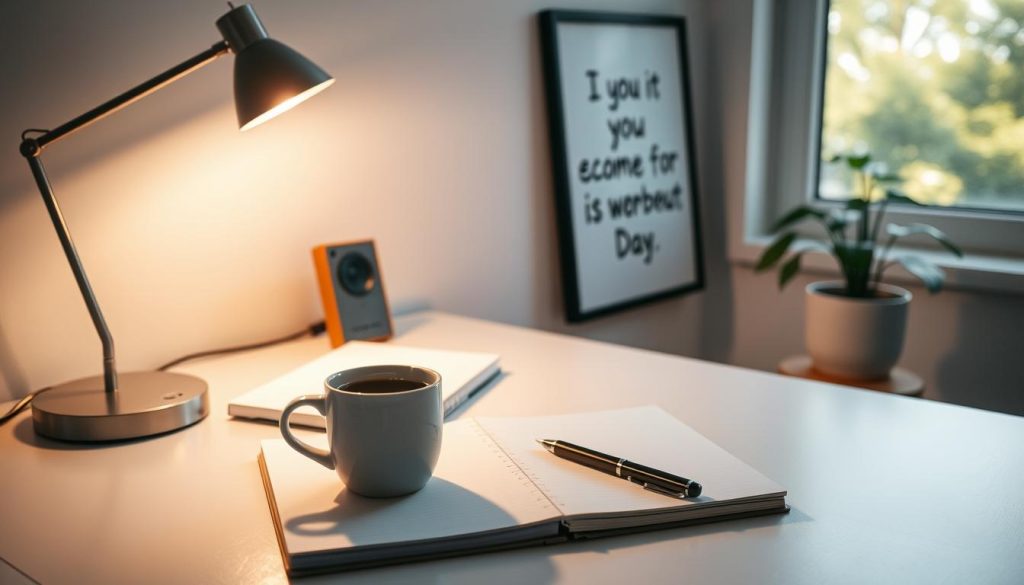Clarence Bleicher once told a US Senate committee that a « lazy man » will find an easier way to solve a hard problem in ten days. That idea—small, efficient rules over brute force—has guided many leaders and writers.
A professional writer like Raymond Chandler used strict « work-or-nothing » sessions. Coaches ask you to write everything into one trusted system and pick the next task to do now. These small acts remove friction and help you reach clear goals.
We frame this article around practical, research-informed help to get started fast. You will find a protective, expert approach so you feel supported while you organize your work and manage your time.
By the end, you will have a simple way to size tasks, protect attention, and finish the day with less mental load. Start with one rule, iterate, and watch your levels of energy and focus improve.
Table of Contents
Key Takeaways
- Use small, protective rules to reduce friction and reach goals.
- Capture every idea in one trusted list to lower cognitive load.
- Choose the next task you can do now to build momentum.
- Align demanding work with your body’s best hours for higher focus.
- Start with one simple rule today, then refine across the week.
Why productivity tips matter more when you work for yourself
Being your own manager means time choices decide income, client trust, and calm. When you run a one-person business, small shifts in how you use hours change the entire workday.
Research on ultradian rhythms shows focus rises and falls across the day. Dr. Melissa Gratias advises scheduling deep, complex work for your biological prime time and lighter tasks for low-energy windows.
Keep fewer priorities. Aim for five to nine main goals so lists don’t become overwhelming. This follows the psychological rule known as “The Magical Number Seven, Plus or Minus Two.”
Without clear management, tasks multiply and the day fills with things that do not move you forward. Define outcomes for each priority and place them where your attention levels are strongest.
- Use morning or late-day peaks for strategic work.
- Reserve low-energy hours for admin and follow-up.
- Build a brief feedback loop each evening to adjust time estimates for tomorrow.
Bottom line: Commit to fewer tasks, match them to your energy, and you create space for deep work while lowering stress. These small rules change the way you work and the results you get.
Prioritize with systems that actually move important tasks forward
A clear method for sorting work prevents urgent noise from stealing your best time. Use simple frameworks to protect attention and ensure your time goes to high-impact work.
Begin the morning by separating what demands a quick response from what truly advances your goals. This reduces reactive management and gives you room to schedule strategic work.
Use the Eisenhower Matrix to sort urgent vs. important work
The Eisenhower Matrix divides work into four quadrants: do now, schedule, delegate, or drop. Apply it once to your backlog, then review fast each morning.
Try the 1-3-5 to-do list to right-size your day
One big, three medium, five small. Choose one major task, three middle-priority items, and five quick actions. The method keeps your list realistic and reduces overwhelm.
Build a “first things” list to help get started in minutes
Turn large goals into one immediate next thing. If that next thing takes under two minutes, do it now. If not, make the next action so small you can get started in minutes.
Adopt the two-minute rule to clear small tasks fast
When a micro-task appears, reply, file, or log it immediately if it takes two minutes or less. This clears clutter and lowers mental load so you focus on important tasks.
- Keep a single visible list for today and a separate backlog to protect focus.
- Schedule strategic items as calendar blocks so the plan becomes time on the clock.
- When you stall, take a short kettle break and return with one clear next thing.
| Method | Primary Use | Best For | Quick Action |
|---|---|---|---|
| Eisenhower Matrix | Prioritizing by impact vs. urgency | Backlog sorting and weekly planning | Move items to four quadrants |
| 1-3-5 To-do List | Daily workload sizing | Right-sizing a busy day | Pick 1 big, 3 medium, 5 small |
| First Things List | Remove start friction | When you need to get started | Define one immediate next thing |
| Two-Minute Rule | Clearing micro-tasks | Inbox and quick administrative work | Do it now if ≤2 minutes |
Plan your day around your attention and energy peaks
Track when your energy naturally peaks and plan deep, focused work for those windows. Keep a short attention journal for one to two weeks to spot your biological prime time. Research shows ultradian rhythms create predictable rises and dips in alertness.
Find your biological prime time using an attention journal
For at least seven days, note simple entries: what hour you feel sharp, when you hit a lull, and what tasks matched those states. This gives clear data you can trust.
Map an attention timetable across your workday
Create a one-line timetable that pairs high-focus blocks with deep work and low-energy slots with routine tasks. Block 60–120 minute increments and include short recovery breaks.
Schedule deep work in your “in the zone” times
Use your morning peak, if that is your pattern, for strategy, writing, or analysis. Protect these hours with DND and autoresponders so you deliver higher-quality results.
- Track energy for ≥1 week to find prime hours.
- Match task types to attention states on your calendar.
- Review weekly and adjust the schedule as real life shifts.
Reduce distractions to protect focus and time

Interruptions are the silent tax on any independent professional; you can reduce their cost with practical signals and simple rules. We recommend small, repeatable actions that keep your attention on the work that matters.
Apply the work-or-nothing rule to single-task
Work-or-nothing is Raymond Chandler’s method: set a fixed window and either work on the chosen thing or do nothing else. This creates a clear boundary and helps you resist context switching.
Put an elastic band on your phone as a tactile barrier
Wrap a simple elastic band across your phone to add friction before you unlock it. That small physical pause breaks automatic habits and protects a portion of your day for uninterrupted work.
Use DND, autoresponders, and website blockers to guard attention
Switch devices to Do Not Disturb, set a brief email autoresponder with your next response window, and run a blocker like StayFocusd during critical blocks. Wear headphones to limit noise and signal that you are not available.
- Capture interruptions on a quick « parking-lot » note and return to the task.
- Automate protections for recurring day patterns so you rely less on willpower.
- Research shows interruptions cost more than the moment they take; refocusing inflates losses.
| Action | Benefit | When to Use |
|---|---|---|
| Work-or-nothing | Deep single-task focus | Complex drafting, analysis |
| Elastic band on phone | Reduces casual checks | Short focused blocks |
| DND + autoresponder + blocker | Fewer digital pulls | Scheduled deep work |
For further reading on organizing your day and improving overall productivity, see our practical guide improving productivity as a freelancer.
Time management methods to build momentum
Short, framed work sessions help you start fast and keep momentum across the day. These simple structures reduce friction and make starting a single task less daunting. Use a clear method and a visible timer to turn resistance into small wins.
Classic Pomodoro: 25 minutes on, 5 minutes off
The Pomodoro Technique divides work into 25-minute sessions followed by a 5-minute break. This rhythm generates forward motion and prevents fatigue that can derail the rest of your day.
Use a single visible timer. Commit to one clear next action for each session so the clock becomes a partner, not an enemy.
Progressive Pomodoros that flex with your focus
When focus is low, begin with very short windows—five minutes—and lengthen as you enter the zone. Progressive blocks might move 5 → 10 → 15 → 30 minutes depending on how flow improves.
Match time to attention. This method helps you respect current energy and still build longer stretches of concentrated work.
Set “kettle deadlines” for quick brainstorms and resets
Use the two to three minutes while water boils to sketch ideas, clear a tiny backlog item, or reset your plan. These kettle deadlines give you a fast mental refresh and a clear next task to return to.
Research shows short, planned breaks maintain cognitive performance; stand, breathe, and refocus during each break so your next session starts stronger.
| Method | Typical Length | Best Use | Quick Rule |
|---|---|---|---|
| Classic Pomodoro | 25 minutes work / 5 minutes break | Daily drafting, focused editing | One timer, one next action |
| Progressive Pomodoros | Start 5 → extend to 30 minutes | Low-focus mornings or recovery days | Scale with your attention |
| Kettle Deadlines | 2–3 minutes | Brainstorm bursts, quick resets | Use short waiting times to act |
Batch, block, and commit to one task at a time
Group similar work into focused blocks so your brain can run the same process repeatedly. Dr. Larry Rosen’s research shows the brain cannot truly multitask; rapid switching drains mental energy and raises errors.
Group similar tasks to reduce context switching
Batch calls, proposals, and invoices together. When you do like with like, you lower switching costs and fewer distractions interrupt flow.
Time block your calendar for projects and email
Reserve clear slots for deep work and separate windows for email. A weekly template—mornings for creation, afternoons for client messages—stabilizes your management cadence.
Use external self-talk to stay focused on one task
Start each block by saying aloud the single task you will finish. This simple cue primes attention and increases follow-through.
- Keep a short to-do list for the current block only.
- Group meetings so one day is not fragmented.
- If you must switch, leave a one-line note about where to resume.
| Action | Benefit | Quick Rule |
|---|---|---|
| Batch similar tasks | Lower context switching, better accuracy | Group by type (calls, admin, drafting) |
| Calendar blocks | Predictable rhythm across the day | Block projects and email windows |
| External self-talk | Stronger commitment to one task | Say the task aloud at block start |
Design a workspace that boosts performance
We design the area around you so your body and attention work together. A few deliberate choices make long work sessions easier and improve results. Start with comfort, then layer light and small signals that keep focus steady.
Support your body with ergonomic desk essentials
Equip your desk with a solid chair, a cushion, and a wrist rest so your body stays aligned. Use a monitor at eye level and keep keyboard and mouse neutral to reduce strain. These changes protect posture and preserve energy over time.
Work near natural light to improve alertness
If possible, place your workspace beside a window. Morning exposure to daylight raises alertness and can raise performance on demanding tasks. Adjust light temperature later in the day to ease eye strain and levels of tension.
Add a plant to sharpen reaction times
Research shows a small plant can make a measurable difference: studies report about a 12% faster reaction time on computer tests. A green element is lightweight to add and helps your brain stay responsive.
Switch locations for novelty and a dopamine boost
When you work from home, define a focused zone and a separate break area. Occasionally change locations—a patio, coworking space, or quiet cafe—to add novelty. These small shifts refresh motivation and help you return to tasks with clearer focus.
For short, practical setups and productivity hacks that fit a French home office, pre-stage chargers, notepads, and water so you do not interrupt flow.
Mindset resets that keep you moving every day

Small, steady actions keep momentum even when the day feels stacked against you. Adopt a non-zero rule: do one small thing toward your goals every day. The size does not matter; the habit does.
Reframe obligations by saying “I get to” instead of “I have to.” This simple change shifts focus from burden to choice and makes it easier to get started on a task or a project.
When perfectionism stalls you, use the rule start it now, fix it later. Ship a rough draft or an outline and iterate with feedback. Action reduces anxiety and speeds learning.
Practical rules to apply
- Timebox work: set a fixed time and stop when it ends to avoid endless tweaking.
- Keep a visible streak tracker for key goals — one tick a day is enough to keep momentum.
- When a thing feels huge, shrink the scope until the first step is trivially small.
| Mindset Move | Short Benefit | How to Use |
|---|---|---|
| Non-zero action | Maintains momentum | Do any small step toward goals each day |
| “I get to” reframe | Boosts intrinsic motivation | Say it aloud before starting a task |
| Start now, fix later | Reduces perfectionism | Ship drafts early, iterate fast |
| Timeboxing | Limits overwork | Set a timer and stop at the end |
If you miss a day, resume immediately without penalty. Momentum builds over time, not by perfect streaks. Protect one small block daily for a strategic project; these micro-investments produce outsized results over weeks.
Smart breaks that restore attention and avoid burnout
A deliberate pause schedule protects your attention and prevents slow drains on energy. Treat breaks as planned components of work, not rewards. Short pauses help you sustain output across the day and keep your brain ready for demanding tasks.
Set a cadence that fits your ultradian rhythms
Align work blocks to natural cycles. Many people do best in 60–90 minute stretches with short recovery between them.
Use a timer and schedule 5-minute breaks after focused sessions or follow a Pomodoro rhythm: 25 minutes on, 5 minutes off. This gives regular micro-rests that protect attention and raise productivity.
Step outside to reduce mental fatigue
Research shows that brief time outdoors reduces mental fatigue and restores focus levels. Even a two- to five-minute walk on a balcony or a quick step into fresh air can refresh your zone.
Micro-movements each hour to reset body and mind
Set a stand-and-stretch alarm each hour. Do shoulder rolls, leg stretches, or a water refill. These small motions ease stiffness and prevent energy dips.
- Plan breaks intentionally and avoid turning them into extra screen time.
- Use longer breaks after two to three cycles to prevent cumulative drain.
- When you return, say the next task aloud to re-enter the work with clarity.
The essential list of productivity tips for independent professionals
Make one source of truth for notes and actions so you spend time doing, not remembering. Centralize your to-do list and notes in one platform to reduce mental load and speed decisions.
Write everything down in one system to free your brain
Keep a clear master list (backlog) and a short daily list. The backlog holds long-term items; the daily list limits what you commit to this day.
Set specific times to check emails and messages
Decide two slots—before lunch and late afternoon—to handle emails. This reduces interruptions and helps you stay focused on important tasks.
Schedule your morning to tackle the day’s most important task
Block your best morning hour for the most important tasks. Use calendar holds and defend them like client meetings.
« A clean system and simple schedule save you time every week. »
- Use templates and a password manager to cut search time and streamline management.
- Pre-stage tools and maintain a tidy desk so you start fast.
- Each evening, write tomorrow’s top three to prime your focus on day one actions.
- Review the list weekly to keep work aligned with goals and real deadlines.
For a practical routine to organize your workday, see organize your workday.
Conclusion
Small, repeatable rules turn scattered hours into steady progress.
Choose one or two ways of working today: write everything down, pick the first action, and defend a single deep block. These simple moves free mental space and move your projects forward.
Use clear time management methods—1-3-5 planning, Eisenhower sorting, and timeboxing—to keep tasks realistic and momentum steady. Protect focus with work-or-nothing sessions, a phone barrier, and calendar blocks so you can stay focused when it matters most.
Upgrade your home or mobile setup with light, a plant, and ergonomic support. Honor short rests between blocks and close each day by noting tomorrow’s first task.
Measure weekly against goals and adjust the way you schedule. Over time, these practices raise performance and reduce stress, giving you a reliable way to do great work. For practical guides on working conditions and setup, see working conditions and environment.
FAQ
Why do focus strategies matter more when you work for yourself?
When you run your own work, you own both goals and execution. Clear focus strategies protect your limited attention, help prioritize billable or growth tasks, and reduce stress by turning vague to-dos into an actionable plan. This preserves energy for high-impact work and supports steady income and stability.
How can I decide what to do first each day?
Use a short system like the 1-3-5 rule: one big priority, three medium tasks, and five small items. Combine this with a “first things” list to get started within minutes. Identify the one task that moves a project or revenue forward and place it in your prime attention window.
What is the Eisenhower Matrix and how do I apply it?
The Eisenhower Matrix separates tasks by urgent vs. important. Put critical deadlines in “do now,” delegate or automate routine items, schedule important but non-urgent work, and drop low-value distractions. This helps you protect deep work periods for revenue-driving activities.
How do I find my best hours for deep work?
Track your attention and energy for a week with a simple journal: note when you feel focused, tired, or distracted. Look for recurring peaks and schedule your most demanding work in those windows. Treat these slots as non-negotiable to build momentum.
What practical steps reduce constant interruptions?
Combine behavioral and technical barriers: adopt a work-or-nothing rule to single-task, use Do Not Disturb and autoresponders for set periods, and install website blockers for time-wasting sites. Small tactile cues—like an elastic band on your phone—also help resist reflexive checking.
How long should I work before taking a break?
Many professionals benefit from cycles aligned with ultradian rhythms—roughly 90 minutes—while shorter cycles like the classic Pomodoro (25 minutes on, 5 off) suit others. Experiment: start with 25/5, then try progressive Pomodoros or 90/20 to see what sustains your focus and energy.
What are "kettle deadlines" and how do they help?
A kettle deadline is a short, sharp time limit you set to push for output—like ten minutes to sketch ideas or 20 minutes to draft an email. These create urgency without perfectionism, help break start inertia, and often produce usable drafts you can refine later.
Is batching tasks really effective for solo professionals?
Yes. Grouping similar tasks—calls, invoices, content drafting—reduces context switching and saves cognitive energy. Time block those batches on your calendar so you protect uninterrupted periods for project work and separate routine chores like email into fixed slots.
How should I design my workspace to support long hours of focused work?
Prioritize ergonomics: a supportive chair, correct monitor height, and a stable desk. Work near natural light to boost alertness, add a desk plant to reduce stress, and change locations occasionally for novelty and a dopamine lift. A tidy, dedicated zone signals your brain it’s time to work.
What mindset shifts prevent "zero days" and procrastination?
Use small, non-zero actions to maintain momentum—ten minutes counts. Reframe tasks with “I get to” instead of “I have to” to boost motivation. Adopt “start it now, fix it later” to overcome perfectionism, and timebox tasks to limit over-tweaking and ensure delivery.
How do smart breaks restore attention without derailing my day?
Align breaks with your energy cycles: step outside for nature breaks to lower mental fatigue, add micro-movements each hour to reset circulation and posture, and set a break cadence that matches your focus spans. Short, active breaks refresh cognition faster than passive scrolling.
How can I manage email without it eating my day?
Centralize messages and set specific times to process them—morning, midday, and late afternoon. Use autoresponders for clients when you need deep focus, prioritize quick triage using the two-minute rule, and batch email blocks so they don’t fragment your attention.
What single habit frees the most mental space for independent workers?
Capture everything in one trusted system. Writing tasks, ideas, and deadlines down reduces cognitive load and prevents missed commitments. Review the system daily to plan your priorities and free your brain to focus on execution, not recollection.





